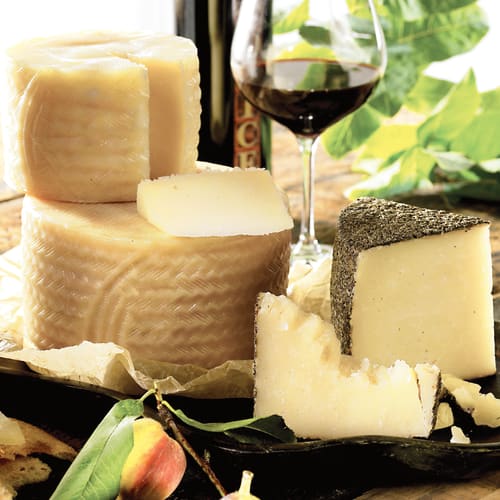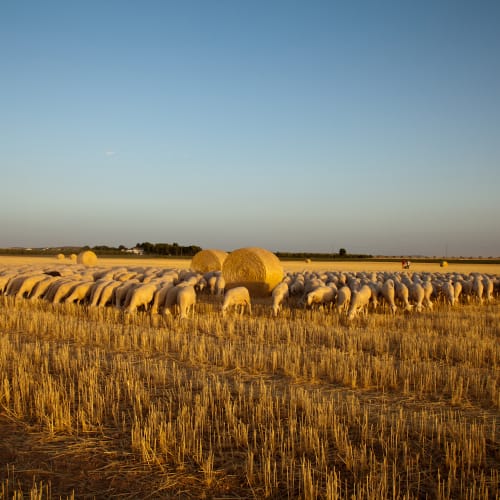The Treasure of La Mancha
March 2007




Let me tell you of a happy coincidence that led my family find one of the very finest Manchego cheeses in Spain. A couple of years ago, our sons Tim and Jonathan, had finished visiting small producers in the south of Spain, and decided to return to Madrid via Extremadura, along the Portuguese border. After driving several hours, they approached Trujillo, one of our favorite towns. They had driven for several hours, it was now late in the afternoon, and it seemed to be a good place to stretch their legs.
For as long as people can remember, a cheese competition has taken place in Trujillo's Plaza Mayor, surrounded by ancient, splendid stone buildings. There are cheeses from rural producers all over Spain: local ones such as the fabled Torta del Casar with its rich creamy interior, and even some cheese from as far away as Galicia, Catalunya or the Balearic Island of Minorca.

From all over Spain, producers are drawn to Trujillo because of the reputation of this historic fair – even people bringing Manchego cheese from distant La Mancha. There are many cheeses called "Manchego" just as there are many cheeses called "cheddar". Some that you will find in the supermarket are industrial cheeses and taste fine. Other cheeses, hand-made by artisans, are finer: they capture the truly artisan tradition. Thereby hangs my tale:
Jonathan and Tim strolled around the many displays of artisan cheeses of Spain, and happened by the stand of a warm and pleasant man named Antonio Villajos. He and his assistant Raul were very excited because their tiny family operation had just won the prize for producing the finest Manchego in all of Spain. It was a particularly remarkable accomplishment because Antonio and his brothers Vicente and Julian only started bringing their homemade cheese to market in 1996!
As my sons sampled the prize winning cheese, they were convinced that this was indeed a remarkable Manchego. What was even better, the hand-made cheese was made by a small family producer - the kind of people La Tienda is committed to supporting.
Now for a little background: true Manchego cheese comes only from sheep of the Manchega strain. Thousands of years ago, wild sheep crossed the Pyrenees, and migrated through various parts of Spain such as Aragón and Castilla-León. Eventually they settled in the high plateau region of La Mancha southeast of Madrid. La Mancha (the Moors called it Al-Mansha "dry land") is a high plain, 600 – 700 meters in altitude, with intense and bitter winters. For some reason, this ancient breed of sheep settled there and remained on the land of La Mancha until the present time.
Iberian archaeological sites confirm that the earliest residents of this vast rolling countryside domesticated the Manchega sheep. Through skillful breeding they improved the stock, without allowing the breed to mix with other kinds of sheep. The Manchega sheep's unique characteristics have hardly changed through the centuries. Both their thick wool grown to resist the cold winters, and their remarkably rich milk are legendary.
These hardy sheep live most of their natural life in the outdoors as they have for centuries. All year long free-range herds of Manchega sheep roam the countryside, foraging amongst the sparse herbs and grasses. In modern times, shepherds enrich the ewes' (female sheep) diet during their pregnancy.

In this sheep country, the terrain is dotted with small villages of hardly more than a main street, with houses on each side and family ranches stretching out into the countryside. The Villajos brothers make their classic cheese in the remote town of Porzuna, nestled in the hills close to the Montes de Toledo in the Province of Ciudad Real. In what was originally their family home they produce a handcrafted cheese. It is made from the fresh raw milk collected from a few local farmers whose Manchega sheep graze on the pastures nearby.
The key to their cheese is the skilled hand of the master cheese maker Beni. Each small batch of cheese made from their rich milk is sampled by a representative of the Denomination of Origin board to certify that it is 100% Manchega sheep's milk and is aged for a minimum of 60 days.
The rinds of these cheeses have the signature herringbone pattern, a legacy of the pattern traditionally imprinted by the woven Esparto grass mats that were used to mould the cheeses. The exterior of the cheeses varies in color from white to yellow, as they are never waxed or colored, as are industrial cheeses.
I know many of you have joined us in enjoying Antonio's authentic, hand made Manchego cheeses. It was a fortuitous chain of events that enabled us to bring to your table an extraordinary Manchego cheese that has earned four Gran Selección prizes in the past five years! (It is a remarkable achievement to win so many of these esteemed awards during such a short term).
What a happy coincidence that Tim and Jonathan stopped to stretch their legs in Trujillo!
With best wishes to you and your family,
Don

